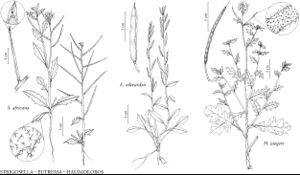Halimolobos
Flora 19: 410. 1836.
| Taxon | Illustrator ⠉ | |
|---|---|---|
 | Strigosella africana Eutrema edwardsii Halimolobos jaegeri | Yevonn Wilson-Ramsey Yevonn Wilson-Ramsey Yevonn Wilson-Ramsey |
Annuals, biennials, or perennials; (base often woody); not scapose; pubescent throughout, trichomes sessile, subsessile, or short-stalked, dendritic and subdendritic, 3–6-rayed. Stems erect or ascending, unbranched or branched distally. Leaves cauline and sometimes basal; petiolate or sessile; basal (often withered by anthesis or fruiting), not rosulate, petiolate, blade margins coarsely dentate or pinnatifid [sinuate]; cauline petiolate or sessile, blade margins dentate or sinuate-dentate. Racemes (corymbose), slightly to considerably elongated in fruit. Fruiting pedicels divaricate or descending, slender, (densely pubescent). Flowers: sepals slightly or widely spreading, oblong; petals white, oblanceolate or spatulate, (± equal to sepals), claw obscurely differentiated from blade, (apex obtuse); stamens slightly tetradynamous, (slightly spreading, equal to or longer than petals); filaments not dilated basally; anthers oblong [ovate], (apex obtuse); nectar glands confluent, subtending bases of stamens. Fruits siliques or silicles, sessile, not or obscurely torulose, linear or ovoid to oblong, terete or angustiseptate; valves each obscurely veined, densely pubescent, (trichomes appressed, [sub] sessile, subdendritic, mixed with coarser, short-stalked, larger ones); replum rounded; septum complete; ovules 16–110 per ovary; style distinct; stigma capitate. Seeds uniseriate in siliques, biseriate in silicles, plump, not winged, oblong; seed-coat (minutely reticulate), mucilaginous when wetted; cotyledons incumbent. x = 8.
Distribution
sw United States, n Mexico
Discussion
Species 6 (3 in the flora).
As delimited by R. C. Rollins (1943, 1976, 1993), Halimolobos consists of 18 species distributed in North America and South America. Detailed molecular studies (C. D. Bailey et al. 2002) and critical evaluation of morphology (Bailey et al. 2007) indicate that Rollins’s concept of the genus corresponds to at least four well-defined genera, Halimolobos in the narrow sense, Sandbergia, Transberingia, and Exhalimolobos, of which only the last is not represented in the flora area. Both Exhalimolobos and Halimolobos are members of the tribe Halimolobeae, Sandbergia belongs to the tribe Boechereae; Transberingia is sister to the Asian Crucihimalaya Al-Shehbaz, O’Kane & R. A. Price of the tribe Camelineae; see Bailey et al. (2002, 2007).
Selected References
Lower Taxa
Key
| 1 | Annuals or biennials (bases not woody); fruits oblong to ovoid, 3-4(-5) mm wide, slightly angustiseptate; ovules (60-)70-110 per ovary; seeds biseriate. | Halimolobos pubens |
| 1 | Perennials (bases often woody); fruits linear, 0.5-0.9 mm wide, terete; ovules 16-38 per ovary; seeds uniseriate | > 2 |
| 2 | Fruits 0.6-1.4(-1.7) cm; ovules 16-24 per ovary; sepals 1.2-2 mm; petals 1.8-2.5 mm; se Arizona, New Mexico, sw Texas. | Halimolobos diffusa |
| 2 | Fruits (1-)1.5-2.6 cm; ovules 28-38 per ovary; sepals 2-4 mm; petals (3.5-)4.5-6 mm; e California, w Nevada. | Halimolobos jaegeri |
"elongated" is not a number."thick" is not a number.